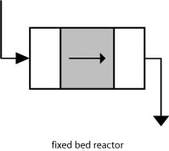
We see anaerobic pretreatment with high strength wastewater that would be difficult and cost prohibitive to treat in a standard aerobic system - maintaining D.O. would require a massive amount of energy. One common application of anaerobic pretreatment is in meat processing wastewater. Often these systems have an anaerobic basin with a grease cap or physical cover following DAF or other pretreatment system. The anaerobic basin microbes grow on soluble organics and via anaerobic biochemistry begin to reduce the carbon chain length making insoluble fatty acids more soluble. This is a much slower process under anaerobic conditions than in an aerobic system resulting in the "grease cap". With a relatively long residence time, the anaerobic pretreatment removes a substantial portion of influent BOD and converts proteins into ammonia which is amenable to rapid treatment in the following activated sludge unit.
While meat processing is a common application of anaerobic pretreatment, it is also useful in many waste streams with long chain organic compounds that require solubilization to become BOD5. Examples include cellulose, fats, and large particulate material.

 RSS Feed
RSS Feed